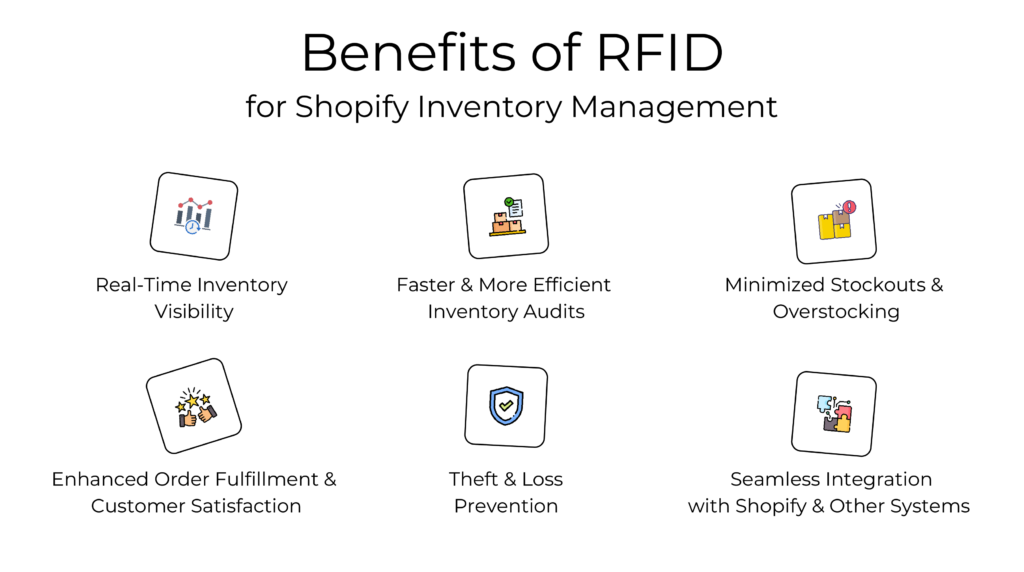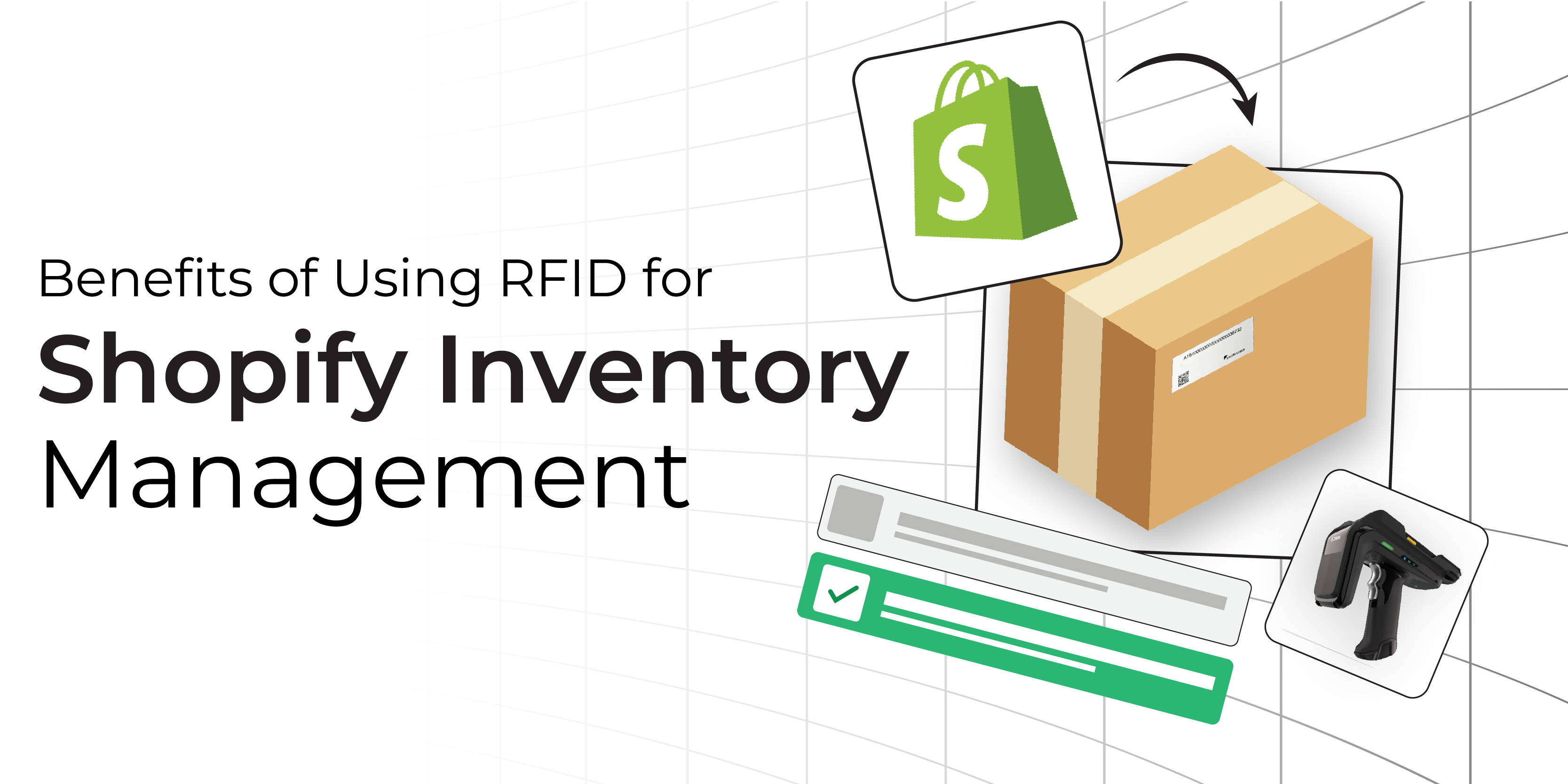Introduction
Shopify has revolutionized e-commerce, making it easier for businesses to set up online stores, manage inventory, and streamline operations. However, as businesses scale, managing inventory efficiently becomes a major challenge. Overstocking, stockouts, human errors, and manual stock checks can lead to lost revenue and poor customer experience.
RFID technology offers a powerful solution for Shopify retailers to overcome these inventory management hurdles. By automating the tracking process, RFID solutions for Shopify retailers ensure real-time visibility, reduce discrepancies, and enhance overall operational efficiency.
What is RFID and How Does It Work in Shopify Inventory Management?
Radio Frequency Identification (RFID) is an advanced tracking technology that enables businesses to track products using wireless signals. Unlike traditional barcode systems, RFID does not require line-of-sight scanning, allowing retailers to monitor multiple items simultaneously.
Components of an RFID System
An RFID system consists of three main components:
- RFID Tags – Embedded in products or packaging, these tags store essential product information.
- RFID Readers – Devices that detect and capture data from RFID tags.
- RFID Software – A central platform that processes and manages RFID data for efficient inventory tracking.
How RFID Works in Shopify Inventory Management
Shopify inventory tracking with RFID enables real-time tracking of stock across multiple locations. When an RFID reader scans an item, it updates the Shopify inventory automatically, reducing manual errors and improving inventory accuracy. Each RFID tag carries a unique identifier, allowing the system to distinguish individual products even within bulk shipments. This ensures precise inventory updates, eliminating discrepancies caused by human error.
Key Benefits of Using RFID for Shopify Inventory Management

Real-Time Inventory Visibility
RFID technology enables real-time inventory tracking, allowing Shopify retailers to have instant updates on stock levels. With RFID, inventory counts are automatically updated as items move through the supply chain, ensuring businesses always have an accurate record of stock availability. This eliminates the need for time-consuming manual stock checks and significantly reduces human errors in inventory tracking. This advanced RFID for Shopify Retailers solution enhances efficiency and ensures better stock control.
By leveraging RFID, retailers can track inventory seamlessly across multiple warehouses, stores, and fulfillment centers, ensuring stock levels are accurately maintained across all locations. The ability to monitor inventory movement in real-time allows businesses to make informed decisions about stock replenishment, transfers, and distribution, optimizing supply chain efficiency. RFID Retail inventory management for Shopify enables businesses to maintain an optimal balance of inventory, preventing stock-related challenges.
Faster and More Efficient Inventory Audits
Traditional inventory audits are often labor-intensive and prone to human errors, requiring significant time and resources. RFID simplifies this process by allowing businesses to conduct bulk scans of inventory items within seconds. Unlike barcode systems, which require scanning individual items manually, RFID readers can capture data from multiple tags at once, making stock audits significantly faster and more accurate.
With RFID, Shopify retailers can perform frequent inventory audits without disrupting daily operations. Businesses no longer need to shut down operations for extended periods to conduct manual stock checks, leading to greater operational efficiency and cost savings. RFID Retail inventory management for Shopify provides retailers with precise audit results, reducing inconsistencies and ensuring inventory accuracy.
By reducing reliance on manual labor, RFID helps businesses allocate workforce resources more effectively. Employees can focus on other essential tasks rather than spending hours conducting stock counts, improving overall productivity and reducing operational costs.
Minimized Stockouts and Overstocking
One of the biggest challenges for Shopify retailers is maintaining optimal stock levels. Overstocking leads to unnecessary storage costs and capital investment, while stockouts result in missed sales opportunities and dissatisfied customers. RFID technology provides real-time data on inventory levels, helping businesses strike the right balance between supply and demand.
With accurate, up-to-date inventory information, retailers can optimize stock replenishment strategies and prevent unnecessary overstocking or shortages. Improved demand forecasting powered by RFID data ensures that businesses can align inventory levels with customer demand, reducing waste and maximizing sales potential. RFID for Shopify Retailers ensures that stock management is optimized to meet customer needs effectively.
Enhanced Order Fulfillment and Customer Satisfaction
Order fulfillment accuracy is crucial for Shopify retailers to maintain customer satisfaction and brand reputation. RFID technology enhances order fulfillment by ensuring that stock levels are correctly reflected in the system, reducing the risk of fulfillment errors. With real-time inventory tracking, businesses can confidently process orders, knowing that the products are available for shipping.
The ability to process orders faster through RFID-enabled automation leads to improved shipping times, helping businesses meet customer expectations for quick and accurate deliveries. Faster order processing not only enhances the customer experience but also improves operational efficiency, reducing order processing delays.
By maintaining accurate inventory records, retailers can prevent issues such as backorders and canceled orders due to stock discrepancies. RFID Retail inventory management for Shopify enables businesses to provide reliable service, leading to higher customer satisfaction and repeat purchases.
Theft and Loss Prevention
Inventory theft and losses can significantly impact a retailer’s profitability. RFID technology enhances security by providing real-time tracking of high-value inventory items. With RFID-enabled asset tracking, Shopify retailers can monitor the movement of products throughout the supply chain, reducing the risk of theft and unauthorized inventory removal.
RFID security features, such as RFID-enabled alarms and tracking alerts, help deter theft and prevent inventory shrinkage. Unauthorized movement of inventory can trigger alerts, allowing businesses to take immediate action to prevent losses. RFID for Shopify Retailers ensures that products remain secure, minimizing financial losses due to theft or mismanagement.
Seamless Integration with Shopify and Other Systems
RFID technology integrates seamlessly with Shopify’s inventory management system, making it easy for businesses to leverage RFID software for Shopify retailers. Solutions such as TagMatiks Retail, connect with TagMatiks RFID Connect, enabling businesses to automate stock updates, order processing, and inventory reporting without manual intervention.
With seamless integration, Shopify merchants can synchronize their inventory data across multiple sales channels, ensuring consistency in stock levels and order fulfillment. RFID automation eliminates the need for manual data entry, reducing errors and improving overall operational efficiency. RFID Retail inventory management for Shopify enhances workflow automation, allowing businesses to scale their operations efficiently.
How to Implement RFID for Shopify Inventory Management
Steps to Integrate RFID with Shopify
Select the Right RFID Tags & Readers – Choose RFID hardware based on product type and business needs.
Deploy RFID Software for Shopify Retailers – Use an RFID software solution like TagMatiks Retail Connect with the help of TagMatiks RFID Connect to integrate with Shopify.
Sync to Shopify – Connect RFID data with Shopify for real-time inventory updates.
Print Tags – Generate and print RFID tags for easy product identification.
Tag Your Products – Attach RFID tags to items for seamless tracking.
Scan Instantly – Use RFID readers to quickly scan and update inventory.
Train Staff on RFID Usage – Educate employees on RFID best practices.
Monitor and Optimize Inventory Operations – Use RFID data insights to refine inventory management strategies.
Choosing the Right RFID Solution for Your Business
Select an RFID software that seamlessly integrates with Shopify while ensuring compatibility with your existing inventory systems. Opt for a scalable solution that can grow with your business, supporting future expansion and evolving inventory needs.
Manage Your Shopify Inventory Using TagMatiks Retail
TagMatiks Retail, integrated with TagMatiks RFID Connect, provides a complete RFID solution for Shopify retailers, offering. This integration provides:
- Automated Stock Updates – Real-time inventory tracking for accurate stock levels.
- Faster Cycle Counting – Speed up counts with improved accuracy.
- Product Movement Insights – Gain visibility into sales trends and stock flow.
- Efficient Order Fulfillment – Streamline warehouse management and shipping.
By leveraging TagMatiks Retail, Shopify businesses can streamline their operations, reduce stock discrepancies, and ensure a seamless shopping experience for customers.
Conclusion
RFID technology is transforming inventory management for Shopify retailers by offering real-time visibility, minimizing stock discrepancies, and improving operational efficiency. RFID solutions for Shopify retailers like TagMatiks RFID Connect provide seamless integration, making inventory tracking effortless and accurate.
If you’re looking to enhance your Shopify store’s inventory management, now is the time to explore RFID. Implementing RFID for Shopify retailers will not only streamline your operations but also provide a competitive edge in today’s fast-paced e-commerce landscape.
